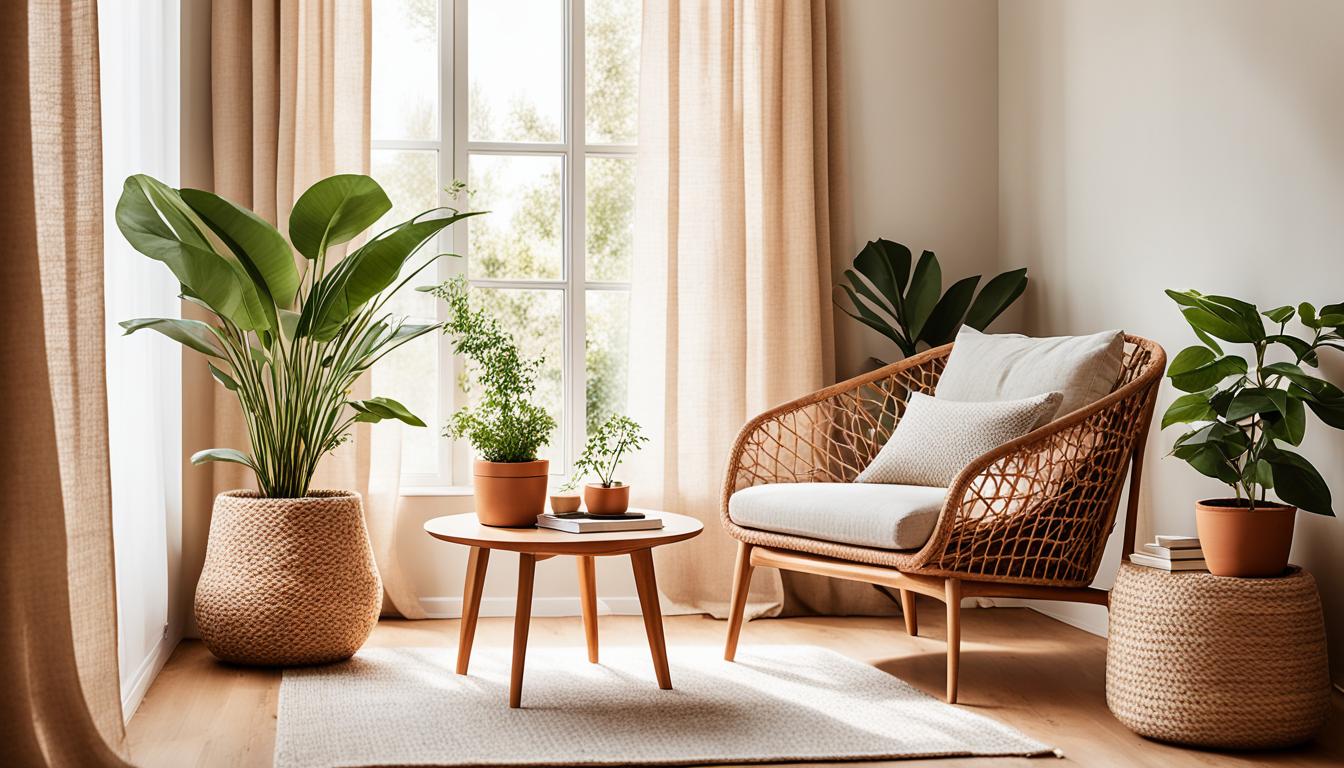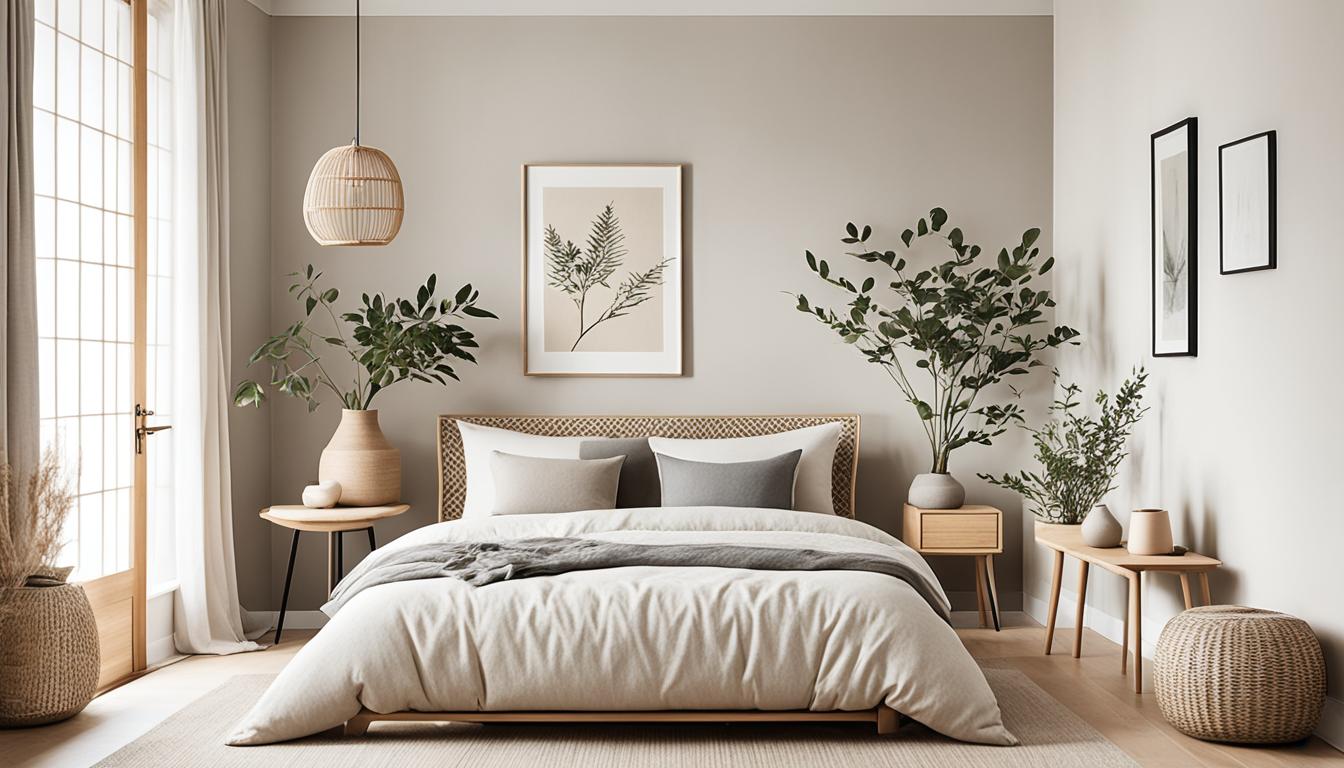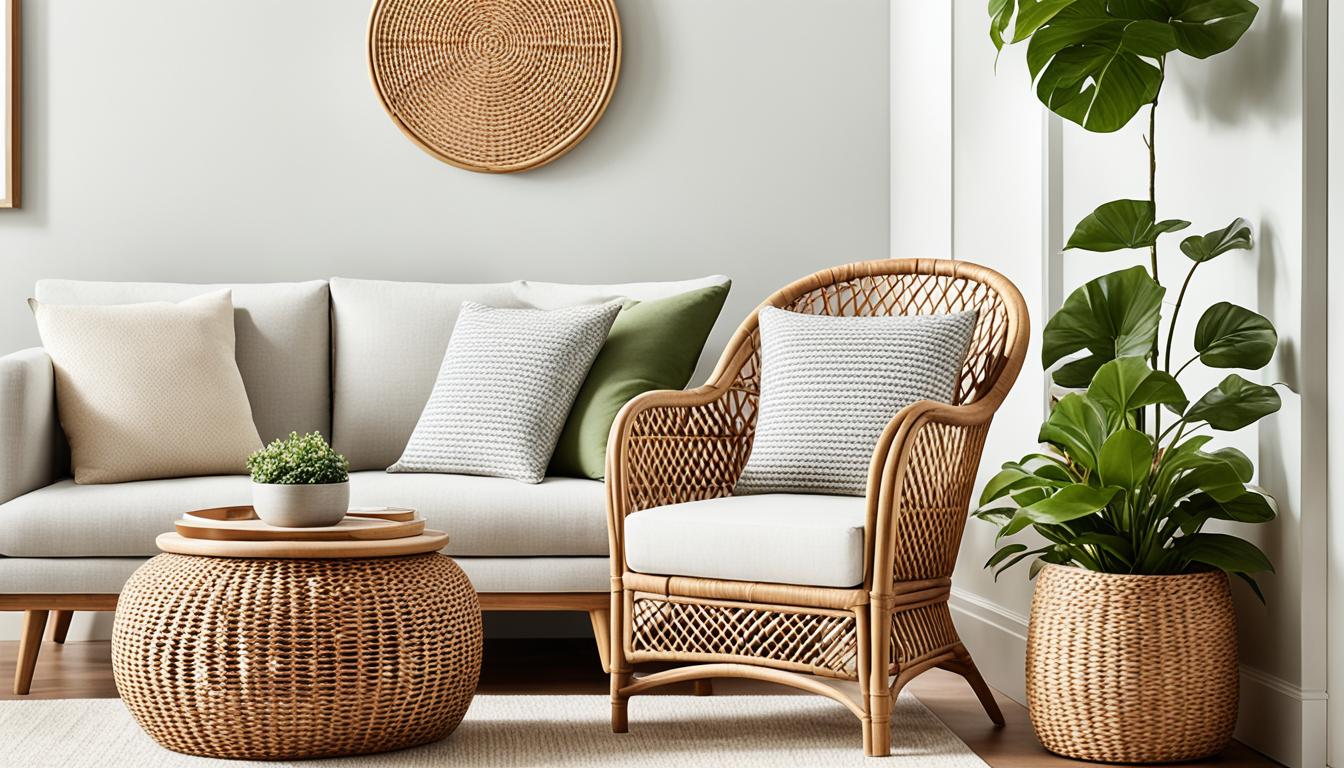🤍 Unmatched Quality, Authentic Craftsmanship
🤍 Unmatched Quality, Authentic Craftsmanship
🤍 Unmatched Quality, Authentic Craftsmanship
Welcome to our blog post on Japandi Rattan design ideas for chic interiors.
If you're looking to create a stylish and harmonious space that combines Japanese and Scandinavian aesthetics, then you're in the right place!
In this article, we'll explore various rattan design ideas that embody the essence of Japandi style, from furniture choices to strategic placement.
Let's dive in and discover how you can incorporate rattan into your japandi home decor to achieve a chic and modern Japandi look.

Japandi Rattan design has become increasingly popular in modern homes as it effortlessly blends the minimalistic elegance of Japanese aesthetics with the clean lines and functional simplicity of Scandinavian design.
A core element of Japandi style is the use of rattan, a versatile material that brings warmth, texture, and a touch of nature to interior spaces.

By incorporating rattan furniture and decor, modern homes can achieve a sense of serenity and balance.
Rattan's natural appearance and earthy tones create a harmonious connection with the surrounding environment, allowing residents to experience a tranquil atmosphere in their everyday lives.
In minimalist interiors, where clutter is kept to a minimum, rattan furniture effortlessly stands out as a statement piece without overpowering the space.
Its organic texture and timeless appeal blend seamlessly with other design elements, contributing to an overall sense of visual harmony.
Furthermore, the inherent durability and flexibility of rattan make it a practical choice for modern homes.
Rattan furniture is lightweight and easy to move, allowing homeowners to effortlessly rearrange their spaces to suit their evolving needs and preferences.
To fully understand Japandi style, we must dig deep into its roots and uncover the historical convergence of Japanese and Scandinavian aesthetics.
Japandi is not simply a passing trend; it represents a lifestyle philosophy that goes beyond the surface level of design.
The fusion of Japanese and Scandinavian aesthetics in Japandi design is a result of the shared values and design principles of these two cultures.
Both Japanese and Scandinavian design philosophies emphasize minimalism, natural materials, and finding beauty in simplicity.
Japanese aesthetics, influenced by the concept of wabi-sabi, embrace imperfection and the beauty of natural materials.
The use of organic shapes, clean lines, and a sense of tranquility are fundamental aspects of Japanese design.
On the other hand, Scandinavian design embraces the concept of hygge, which focuses on creating cozy and inviting spaces.
Simplicity, functionality, and a strong connection to nature are key elements in Scandinavian interiors.

When these two aesthetics converge, Japandi style is born.
It combines the minimalist approach of Japanese design with the warmth and coziness of Scandinavian interiors, resulting in a harmonious and serene living environment.
Japandi style goes beyond being just a design trend. It represents a lifestyle philosophy rooted in simplicity, balance, and a deep connection with nature.
Adopting Japandi in your home means embracing a way of life that values natural materials, minimalist decor, and intentional living.
The minimalist approach of Japandi design encourages us to let go of excess and focus on what truly matters.
By decluttering our space and surrounding ourselves with essential items, we create a sense of calm and serenity.
The use of natural materials, such as wood, rattan, and bamboo, brings a sense of authenticity and warmth to Japandi interiors.
These elements not only enhance the aesthetics but also connect us to the natural world, promoting a deeper appreciation for our surroundings.
Living the Japandi lifestyle means finding joy in the simple pleasures of life, creating spaces that promote relaxation and well-being, and embracing the beauty that can be found in the everyday.
It is a way of life that encourages us to slow down, be present, and find contentment in the present moment.
In this section, we will dive into various Japandi rattan design ideas.
From rattan furniture choices to incorporating natural elements and creating functional designs, we will provide japandi style tips and inspiration for achieving chic interiors.
Whether you're looking to revamp your living room, bedroom, or office space, these design ideas will help you create a harmonious and stylish Japandi-inspired environment.

When it comes to Japandi design, rattan furniture is a key element.
It adds a touch of warmth and texture to chic interiors while staying true to the minimalist decor.
Consider incorporating rattan chairs, tables, or even hanging swings to create a cozy and stylish seating area.
In addition to furniture choices, incorporating natural elements is essential for achieving an authentic Japandi look.
Add potted plants or floral arrangements to bring a touch of nature indoors. You can also include bamboo accents or wooden accessories to further enhance the natural aesthetic.
Functional design is another crucial aspect of Japandi interiors.
Look for rattan storage solutions, such as baskets or shelves, that serve both a practical purpose and add to the overall aesthetic.
Utilize woven rattan room dividers to create separate areas within an open space while maintaining a cohesive Japandi design.
By incorporating rattan furniture ideas, natural elements, and functional design, you can create a truly serene and stylish Japandi-inspired home.
Mixing rattan with minimalist decor is an art that can elevate the elegance of Japandi interiors.
Rattan furniture, with its natural texture and organic beauty, adds warmth and character to a minimalist space.
By strategically blending rattan elements with clean lines and simple designs, you can create a subtle statement that enhances the overall Japandi elegance in your home.
When selecting rattan furniture for your Japandi interior, opt for pieces that feature clean and minimalist designs.
Look for streamlined chairs, sofas, tables, and shelving units that maintain the simplicity of the overall decor.
The goal is to achieve a balanced and harmonious look where the rattan furniture serves as a focal point without overpowering the minimalist aesthetic.
Consider incorporating rattan accent pieces such as lamps, mirrors, or plant stands to add texture and visual interest to your space.
These small touches of rattan can make a significant impact without overwhelming the minimalist design.
Where you place your rattan furniture is key to creating the perfect balance between minimalism and nature.
Strategic placement allows you to highlight the beauty of the rattan while maintaining a cohesive and serene atmosphere.
Here are a few placement ideas to enhance the Japandi elegance:
Experiment with different placements and configurations to find the perfect balance between your minimalist decor and the understated beauty of rattan furniture.

Natural elements are essential in creating harmonious and tranquil Japandi interiors.
By incorporating wood, bamboo, and rattan into your design, you can achieve a cohesive and balanced aesthetic.
These natural materials work together to form a trio that contributes to the wholeness of Japandi style.
Wood, bamboo, and rattan are key elements in Japandi interiors. Wood brings warmth and natural beauty to the space, while bamboo adds a touch of elegance and simplicity.
Rattan, with its organic texture, provides visual interest and a sense of earthiness.
When combined, these natural materials create a harmonious balance that embodies the essence of Japandi design.
Earth tones are integral to the Japandi palette and play a crucial role in creating a serene and natural ambiance.
Shades of brown, beige, and muted greens evoke a sense of tranquility and connection to nature.
These earthy hues can be incorporated into walls, furniture, and accessories, infusing the space with warmth and grounding the overall aesthetic of Japandi interiors.
Incorporating natural elements and earth tones into your Japandi interiors will not only create a visually appealing space but also promote a sense of calm and balance.
Embrace the beauty of wood, bamboo, rattan, and earthy colors to achieve a truly authentic Japandi design.
Accessories play a crucial role in creating harmony in Japandi interiors.
In addition to furniture and decor, incorporating rattan accessories can enhance the overall Japandi style and bring a touch of nature and warmth to minimalist decor.
When strategically placed, rattan accessories can create a cohesive and stylish Japandi interior.
From rattan baskets that add texture and storage solutions to decorative pieces that infuse natural elements into the space, these accessories contribute to the overall aesthetic.
To inspire your Japandi design journey, consider incorporating rattan accessories such as table lamps, wall hangings, and planters.
These pieces not only enhance the visual appeal of the space but also create a sense of balance and tranquility.
Incorporating rattan rattan decor trends into your Japandi interior allows you to add functional and decorative elements that complement the minimalist decor while creating a harmonious atmosphere.
Embrace the beauty of rattan decor pieces and create a serene and stylish home.
Japandi Rattan design is not limited to residential spaces; it can also be incorporated into office design.
The seamless blend of Japanese and Scandinavian aesthetics, combined with the natural warmth and texture of rattan, can create a functional and aesthetic office space that promotes productivity, tranquility, and style.
When designing a minimalistic workspace, consider incorporating rattan office furniture.
Rattan chairs, desks, and shelving units can add a touch of nature to the office while providing comfort and functionality.
The organic shapes and earthy tones of rattan furniture create a soothing environment that promotes focus and creativity.
In addition to furniture, there are various office decor ideas that can enhance the Japandi aesthetic.
Incorporating rattan storage baskets, desk organizers, and plant holders can bring natural elements into the workspace, adding visual interest and functionality.
To further establish the Japandi style, consider incorporating traditional Japanese elements such as shoji screens or sliding doors.
These elements can create privacy, separate different areas of the office, and add a unique touch to the overall design.
By utilizing Japandi rattan in office design, you can create an environment that combines minimalism, aesthetics, and functionality.
The natural beauty and tranquility of rattan, paired with the simplicity and balance of Japandi style, can transform your workspace into a harmonious and inspiring place to work.
Japandi design embraces eco-friendly and sustainable practices, making it an ideal choice for those seeking to create a stylish and mindful living space.
By incorporating eco-conscious rattan pieces, you can enhance the overall sustainability of your Japandi interiors.
Choosing rattan furniture made from responsibly sourced materials ensures that you are making an eco-friendly and ethical choice.
Rattan is a natural and renewable resource, known for its durability and versatility.
It is a fast-growing vine that requires minimal chemical treatment, making it an eco-conscious option for furniture and decor.
By opting for rattan pieces that have been manufactured using sustainable practices, you can enjoy the beauty of Japandi design while minimizing your impact on the environment.
Furthermore, Japandi design promotes the longevity and timeless nature of interiors.
Instead of constantly changing your furniture and accessories, Japandi design encourages you to invest in high-quality pieces that can withstand the test of time.
By prioritizing quality over quantity, you contribute to a more sustainable and mindful lifestyle.
Now that you have read the above article, maybe you still have a couple of questions on this topic, so we will answer these questions below.
Japandi Rattan design is a popular interior design trend that combines Japanese and Scandinavian aesthetics.
It incorporates rattan as a key element, adding warmth, texture, and a touch of nature to chic interiors.
Wood, bamboo, and rattan can be incorporated into Japandi interiors to create a sense of wholeness and harmony.
Earth tones also play a significant role in enhancing the overall aesthetic of the space.
Mojo Boutique is a great place to find rattan furniture and decor pieces.
These boutiques often curate a collection of unique and handcrafted items, including rattan furniture, that you won't find anywhere else.
These pieces not only add a touch of bohemian luxury to your home but also support local artisans and sustainable practices.
In conclusion, Japandi Rattan design offers endless possibilities for creating chic and harmonious interiors.
By incorporating rattan furniture, mixing it with minimalist decor, and incorporating natural elements, you can transform your space into a serene and stylish haven.
With a focus on simplicity, balance, and nature, Japandi design reflects a lifestyle philosophy that goes beyond just a passing trend.
The combination of Japanese and Scandinavian aesthetics, blended with the warmth and texture of rattan, creates a unique and inviting atmosphere in your home.
Use these design ideas and tips to create your own Japandi-inspired home and enjoy the beauty and tranquility it brings.
Whether you're looking for rattan furniture inspiration, chic interior styles, or tips to incorporate Japandi design elements, we hope this article has provided you with valuable insights to create a serene and stylish home that reflects your personal style and appreciation for nature.


